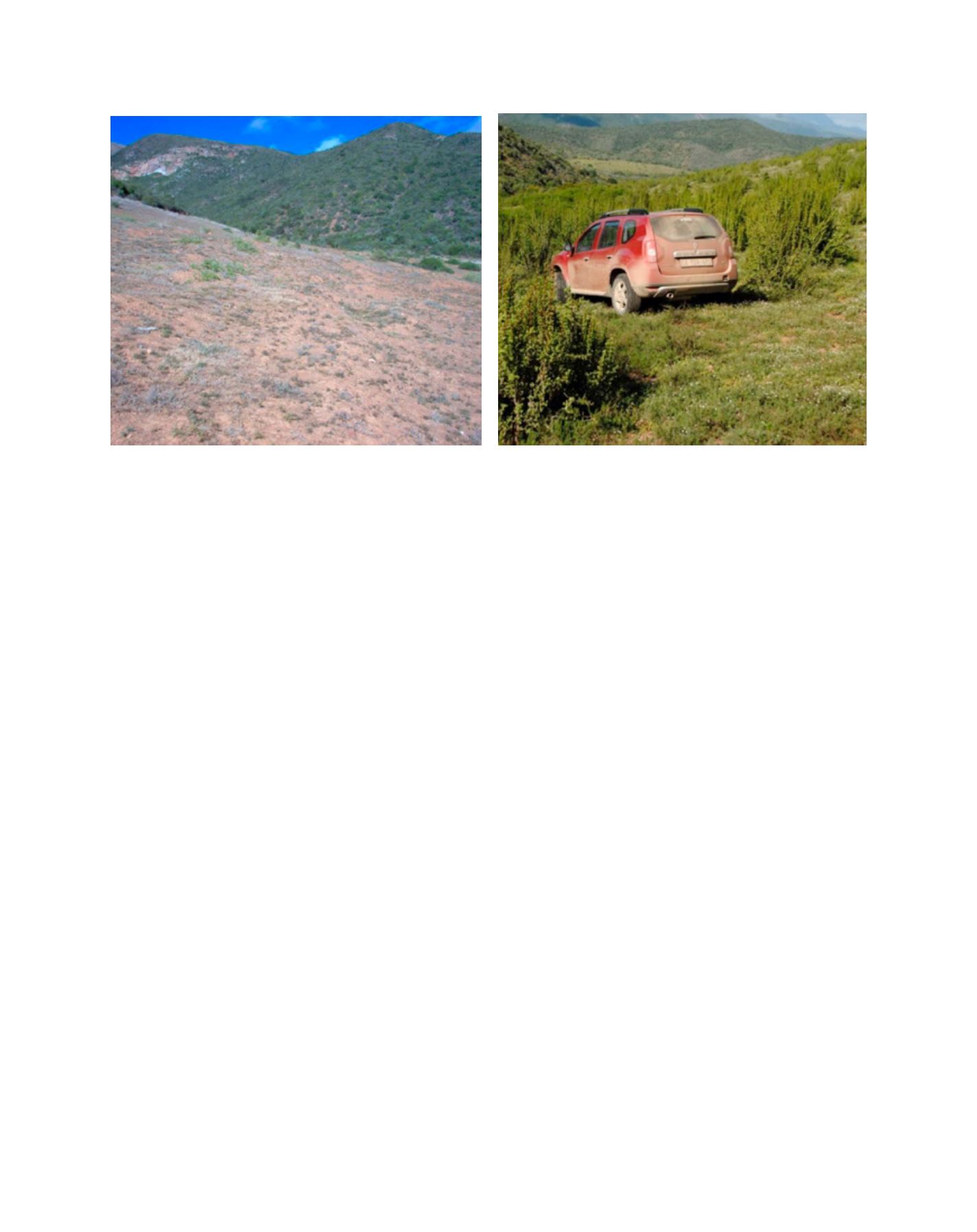

[
] 54
Image: Mike Powell (left), Christo Marais (right)
mean annual run-off with a high of 8.4 per cent in the Southern
Cape. The catchments with the highest impacts all fall within the
Maloti-Drakensberg range, the ‘water tower’ of South Africa that
supplies water to KwaZulu-Natal and Gauteng Provinces, and the
Southern and Eastern Cape mountain ranges that supply water
to the Nelson Mandela Metropole (Port Elizabeth), the economic
hub of the Eastern Cape, the Garden Route (one of the country’s
ecotourism draw-cards), the catchment areas of Cape Town and
the wine lands in the Western Cape.
5,6
Not all the water used by
invasive alien plants is utilizable by humans though. In 2007 it
was estimated that invasive alien plants in high-yield catchments
and along riparian zones reduced usable water (registered water
use) by more than 4 per cent and if left unchecked this could
increase to more than 16 per cent. A water-scarce country like
South Africa simply cannot afford this.
7,8
Large-scale desertification is mainly caused by abandoned
croplands, overgrazing and unsustainable use of timber and
other fibre resources. Other contributing factors are unsustaina-
ble fire regimes — short fire return periods, burning during the
wrong season and then grazing the land too soon after the last
burn. These can all lead to major erosion, especially in the high-
yield catchments. Five of the country’s large dams have been
silted up by more than 60 per cent and the worst of them, the
Welbedacht dam, is silted up by more than 90 per cent.
9
Such
figures don’t represent the full picture, though, as many smaller
dams are also silted up but this information is not captured
in the national records. One such example is the municipal
dam of the small rural town of Mount Fletcher in the Eastern
Cape. The dam, which has a catchment of 77,100 hectares and a
storage capacity of 500,000 m
3
, was completed in 2008. Within
five years it was more than 80 per cent silted up.
From the above it is clear that not only does land degradation
have a major impact on water security, it also impacts negatively
on our ability to adapt to climate change. All climate change
models point to an increase in the intensity of both droughts
and floods, combined with extreme temperatures. South
Africa simply cannot afford not to invest in the restoration of
its ecological infrastructure. In the Eastern Cape Subtropical
Thicket Restoration Programme, of which more than 11,000
hectares is already under restoration, not only does restora-
tion have the potential to increase carbon capture by around
80-100 tons of above-ground and soil carbon per hectare, but
intact thicket also increases infiltration significantly.
10,11,12
Research has shown that more than 100 times lower infiltration
in soils associated with degraded thicket, relative to the soils
under intact vegetation, results in lower levels and less reten-
tion of soil moisture, almost double the amount of run-off and
an almost six-fold increase in sediment load.
13
The increased
run-off might sound positive but it all happens as part of flood
flows and leads to a reduction in dry season flows. Water-scarce
South Africa cannot afford to lose dry season flows.
At the moment it is estimated that the South African
Government invests around US$166 million per year overall, of
which the Natural ResourceManagement Programmes contribute
about US$147.6 million. In order to get on top of the challenge
though, the country will need to invest around US$1 billion per
year, adding around 100 000 jobs to the economy.
14
Footing such
a bill is unaffordable for the South African Government alone. All
enterprises depend on water and energy; it is therefore a logical
imperative that the private sector increases its commitment to the
restoration of the country’s ecological infrastructure and the deliv-
ery of ecosystem services. Once the private sector has internalized
the impacts of catchment degradation on profitability, sustainabil-
ity and risk reduction, investments in ecological restoration could
be absorbed into companies’ investment in enterprise and supplier
development. The restoration of ecological infrastructure not only
improves water security, contributing to economic growth and
livelihood security; it is also a critically important contribution to
managing climate change. To unlock resources the country will
need a legislative platform allowing for incentives to restore and
disincentives to degrade, backed up by appropriate institutions to
facilitate investments in ecological infrastructure.
The slope facing up the valley at the Cambria site (left) shows hardly any above-ground biomass in 2004; (right) the view of the slope from the top of the
valley in December 2014
L
iving
L
and
















